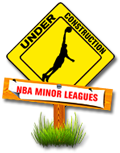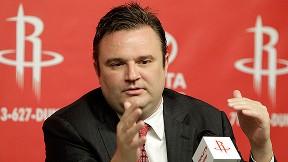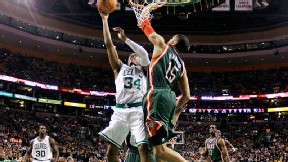This topic contains 1 reply, has 2 voices, and was last updated by ![]() BasterdInABasket 11 years, 6 months ago.
BasterdInABasket 11 years, 6 months ago.
- AuthorPosts
- Posted on: Wed, 10/03/2012 - 7:30pm #43630

J-rueMykelParticipanthttp://insider.espn.go.com/nba/story/_/id/8446927/nba-full-nba-minor-league-system-look-like
Please and Thank You!
0 - Posted on: Wed, 10/03/2012 - 8:00pm #717918

BasterdInABasketParticipantIf the NBA had a minor league system like MLB’s, what would it look like? How would it work?
Editor’s Note: This is the first installment of a five-part series examining the possibility and impact of a full NBA minor league system similar to the model used in Major League Baseball. Today we explore what the "architecture" of such a system would be.

NBA and the minor leagues
Insider asks: What would happen if the NBA had a full minor league system similar to that of MLB?
10/1 Doolittle: Framing a minor league
10/2 Coon: Inside the finances
10/3 Thorpe: Player development issues
10/4 Ford: Impacting the draft
10/5 Paine: Projecting the players
Player development was just not a term you used to hear much in reference to the NBA. The league had a feeder circuit all right, but it was called the NCAA, and it produced a steady supply of three- and four-year college players with relatively polished skill sets and mature bodies. Sure, you’d run across the occasional big man "project" once in a while, or a player would bubble up from the Continental Basketball Association.
Things changed when Kevin Garnett was at the vanguard of the groups we now refer to as preps-to-pros and one-and-done players. These raw, athletic marvels wowed NBA talent evaluators with irresistible upside, but also lugged with them immense risk. For every Garnett there has been a Jonathan Bender. For every Kobe Bryant, there’s a Korleone Young.
And after Isiah Thomas swung his personal wrecking ball at the CBA in 2001, it became apparent that there was something missing, a kind of finishing school for players with unbridled ability, or a proving ground for guys scouts missed. The NBA continued to badly swing and miss on young players.
Part of the problem was the difficulty in projecting the growth of 18- and 19-year-olds. But it’s also how to develop the skills of a player who has the talent, but not the polish, to earn NBA game time. Only the elite talents such as LeBron James or Kevin Durant are able to sharpen their teeth in big-minute roles in the NBA. Everyone else learns by watching, or they don’t learn at all — until the NBA Developmental League was established.
Push for development
There was an undeniable economic impetus behind the growing importance of the minor league, which of course caught the attention of David Stern. To cite just one example, Bender produced 3.8 win shares, according to Basketball-Reference.com, and for that he was paid nearly $31 million over eight NBA seasons. His first two seasons in the league were in the years immediately prior to the formation of the NBDL, and he played a total of 704 minutes for the Pacers. What if he had played 3,000 minutes for the Roanoke Dazzle? Could the Pacers have recouped some of their considerable investment?
One league official said there "absolutely" would be fewer draft misses if elite talents were allowed to log extended minor league development time, and added that it’s going to take time for teams to realize that the expectation level that accompanies high draft picks is less important than a player being allowed to develop on the court in game situations. That’s the dynamic Stern sought when he announced an expansion of the NBDL in 2005.
"The absence of a firm-footed, successful development league is something that has gnawed at me over the years," Stern told reporters at the time, adding, "I hope our development league ultimately will be a place where youngsters could be assigned in their early years in the league."
Enter the D-League
Soon thereafter, the NBDL was rebranded as the NBA Development League or, simply, the D-League. Stern moved the D-League’s offices to New York and streamlined the operations between the two circuits. Before long, the D-League became a version of the proving ground long envisioned by Stern, with the number of call-ups increasing on an annual basis.
"It’s been good for me to see guys like [Lou Amundson and Mike Harris] to find their way into the NBA," says Timberwolves player development assistant Shawn Respert, who spent two years working in D-League offices. "I can say their success has come from some of the things we tried to incorporate in the D-League."
Last season, a record 44 players found their way from the D-League onto an NBA roster.
"We offer the fastest path to the NBA, and I have numbers to back that up," says Dan Reed, the energetic young president of the D-League. Consider Reed’s numbers:
• There were 120 players with D-League experience on NBA rosters at the end of last season. That represented 27 percent of all NBA players.
• There were 60 D-League players on playoff rosters.
• Through last season, 166 players have earned call-ups, and including players who have been tabbed more than once, there have been 270 instances of a player being promoted from the D-League.
• More than 30 NBA coaches honed their skills in the D-League, as did one general manager: New Orleans’ Dell Demps. Also, every referee hired by the NBA since 2002 has spent time in the D-League.
Reed is quick to cite the D-League’s operational integration with the NBA as the factor that no other league in the world can match. The D-League still doesn’t pay as well as many foreign leagues, but it’s hard to argue Reed’s point. The D-League has kicked into high gear over the past couple of seasons, a period in which seven NBA teams have developed single-affiliate relationships with D-League franchises. During the 2012-13 season, 11 NBA teams will have one-on-one affiliations with a D-League franchise, leaving the other 19 teams to share the five remaining franchises.
 AP Photo/Pat SullivanHouston GM Daryl Morey was the first to establish a hybrid model of a D-League affiliate.
AP Photo/Pat SullivanHouston GM Daryl Morey was the first to establish a hybrid model of a D-League affiliate.The Houston Rockets became the first team to develop the hybrid model of D-League affiliation, in which they have a dedicated relationship with the Rio Grande Valley Vipers. Rockets GM Daryl Morey and his staff have total control of all basketball operations for the Vipers, but business-side operations remain the domain of the Rio Grande-based ownership of the Vipers.
"You learn about players, learn about coaches and try new ideas," Morey says. "When we looked at the hybrid model, it gave you upside without any of the downside. The minor league team is way more knowledgeable about their market than we are."
That trend will continue, especially given the cost-benefit ratio. When the Celtics announced a single-affiliate relationship with the Maine Red Claws this season, it was reported the overhead will cost Boston around $220,000, or about half the minimum salary of a second-round draft pick.
"We have several other NBA teams interested," Reed says, referring to the trend towards single affiliation.
Stern and his quorum of NBA owners cast a vote for the D-League during the last round of labor negotiations by expanding the relationship between the leagues. Beginning last season, veteran players could be allocated to the D-League, whether to rehab an injury or to work into shape. Starting this season, any player with less than three years of experience can be sent down as many times as his parent club desires. Yet, there is still something missing.
Perception vs. pragmatism
Remember when Hasheem Thabeet was assigned to the D-League in the 2009-10 season? He became the highest-drafted player to be allocated to the minors and it was widely viewed as a demotion.
While some players, such as former Philadelphia 76ers forward Craig Brackins, have actually requested D-League assignments just to get minutes, the stigma of being "sent down" is a paradigm that even Reed admits needs to be overcome. What would help is for a player such as Thabeet — who put up big numbers in his limited D-League stints — to use that experience as a springboard toward fulfilling the potential that got him drafted so high in the first place.
"We’re still waiting for the unpolished guy to be sent to the D-League and really take off based on his D-League experience," said one league source, who added that he doesn’t see Jeremy Lin as an example of that.
 AP Photo/Charles KrupaA player like Tobias Harris (right) might benefit from some D-League time instead of the NBA bench.
AP Photo/Charles KrupaA player like Tobias Harris (right) might benefit from some D-League time instead of the NBA bench.For that white whale to be speared, NBA teams need to better use the structure in place. Utah’s Enes Kanter played just 13 minutes per night as a rookie, but didn’t log any D-League time. Neither did Tobias Harris, who at the age of 19 put up a 14.2 PER in just 479 minutes for the Milwaukee Bucks and got everybody excited about his potential. Yet he spent most of the season watching Mike Dunleavy and Carlos Delfino from the Bucks’ bench rather than logging 30 minutes per night for the Fort Wayne Mad Ants.
"We think that in time, it will be the norm rather than the exception for young players to spend developmental time in the D-League," Reed says.
For that to happen, you have to give each team equal access to the league, so we could eventually be looking at a baseball-style architecture. That arrangement might include:
• A dedicated affiliate that has geographic proximity to its NBA parent club. When the Golden State Warriors became the fourth team to purchase a D-League franchise of its own last year, it allowed the established Dakota Wizards to play a final season in Bismarck, N.D., then moved it to nearby Santa Cruz, Calif., for the 2012-13 season. Indeed, all the single-affiliate D-League franchises enjoy geographic proximity to their parent teams.
• Roster exceptions that will allow them to leave players in the D-League for months at a time, or even a full season, without having to summon prospects to fill roster gaps that crop up due to injury spates. This, of course, will have to be collectively bargained.
• Elimination of the current 10-day contract and replaced by a "call-up" system similar to baseball’s. The D-League affiliate will be a mixture of prospects and fringe veterans, all of whom are operating identical offensive and defensive schemes with the same terminology of their parent clubs. This will be the pool of talent from which teams get through the inevitable roster shortages caused by an 82-game season.
• A collectively bargained mechanism that protects a team’s affiliate players. Currently, even teams with single-affiliate relationships only control allocated players working under NBA contracts. Other players on their affiliates can be snapped up by other NBA teams, a point of contention for those who lose players they’ve discovered through the acumen of their scouting department.
• A provision to prevent NBA-worthy players from being trapped at that level through draft-and-stash strategies, so you’d see something similar to baseball’s Rule V draft.
• An expansion of the NBA draft to three rounds. Currently, you could easily trim the draft back to one round and no one would blink an eye. However, if you have a fully mature affiliate system in place, teams would leap to scout and draft assets that could be evaluated and developed in its own program.
Reed thinks we’re clearly headed toward a 30-team, 30-affiliate structure. However, he declined to place a timeline on that process and emphasized the D-League is focused on "steady, sustainable growth over time." So no, we won’t see a 14-team expansion of the D-League next year. However, the "true minor league" Stern envisioned seems well underway.
Says Respert: "We absolutely want to make sure that teams have an equal amount of resources to draw from and a factory to be able to produce the things that they need to ensure the success of their franchises."
Tomorrow: Financial impact
0 - AuthorPosts
| You must be logged in to reply to this topic. | Login |